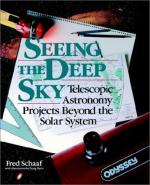|
This section contains 696 words (approx. 3 pages at 300 words per page) |

|
Astronomical seeing refers to the ability to view celestial objects through the obscurations of the earthüs atmosphere. These obscurations include opacity, scattering, turbulence, atmospheric and thermal emission, and ionization.
Opacity refers to the fact that the earthüs atmosphere is transparent only to relatively narrow wavelength ranges of light. These include visual light, the near infrared, microwaves and radio waves with wavelengths between about 0.35 millimeter and one meter. The atmosphere is nearly completely opaque to ultraviolet light, x rays, gamma-rays, and radio waves with wavelengths greater than one meter. The need to observe heavenly bodies outside of these narrow wavelength windows, along with the desirability to avoid the degrading affects of the atmosphere are among the main reasons for the development of space-based telescopes.
Ultraviolet photons are absorbed by electron transitions in oxygen and ozone atoms in the upper atmosphere. Because the amount of ozone...
|
This section contains 696 words (approx. 3 pages at 300 words per page) |

|


